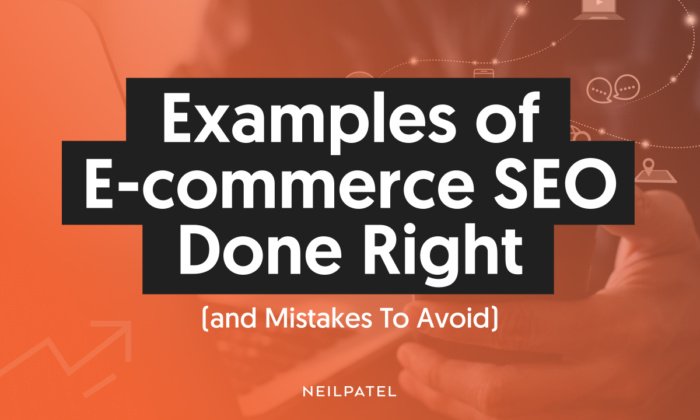Examples of E-commerce SEO Done Right (and Mistakes To Avoid)

We all know the foundation of e-commerce SEO is keyword research.
Over half of shoppers surveyed in a global retail study say they use Google to research purchases they plan to make online.
This is why SEO is your golden ticket to increasing organic visibility.
How?
Think about it: Before you create your site’s content, you need to know what terms your audience is using to search for products like yours.
How will you solve their problems without knowing the keywords behind their search intent?
You have to build your content with search engines and your users in mind.
The sooner you understand how SEO is changing and adapt your strategies, the sooner you’ll see ROI from e-commerce SEO.
Isn’t it impressive how far SEO has progressed?
Jump on the SEO train with me and I’ll show you why it’s important.
Why Is E-commerce SEO So Important?
You’re trying to get new customers to have all eyes on you.
You can’t win their attention if search engines can’t easily find you.
Your site is basically the secret menu at Starbucks if you don’t invest in keyword research.
That’s why it should be the critical first step in your e-commerce SEO campaign.
One of two things will happen if you don’t get SEO for e-commerce right:
You won’t rank on page one—or near the top—because your target keywords are too difficult.The keywords you choose won’t drive in the traffic you’re aiming for or align with customers’ search intent.
However, getting your potential customers’ attention can be expensive.
For example, the average cost per click for the apparel industry is about 89 cents. The average cost per action is right below $10 when you break down WordStream’s results. Cost per action is a pricing model where payment is contingent on a qualified specific action, like a sale or submitted form.
While cost per click generates fast, profitable sales, you could spend thousands reeling in new customers.
By using SEO for e-commerce, you’re gaining free organic traffic by getting your site to show up in the SERPs.
But there are some missteps you should avoid if you want to see success.
Common E-commerce SEO Mistakes
What are the user’s needs?
If you keep this question top of mind, you should have a solid e-commerce SEO campaign.
Here is a list of at least three e-commerce SEO mistakes I don’t want you to make:
Vague Product Descriptions: This is a place to fit in keywords that make sense for your product. Write a product description so your customer knows what to expect. Even when you’re naming the product, think about a user’s potential search queries. Optimizing your product pages gives them a great chance at a top ranking for items. Product descriptions provide clarity and answer important questions that encourage users to follow through with their cart.Display of Product Reviews: The beautiful thing about product reviews is they’re customer generated. It’s basically on-screen user-generated content. Reviews share customers’ unique experiences with your product. The page is like a living update, bringing more people to your site. Take advantage of the SEO benefits reviews bring to your e-commerce site. For added benefits, make sure you implement product review schema so your reviews will be even more prominent in Google SERPs. Non-Interactive Title Tags: Titles are not only a matter of SEO. They should line up with your users’ search intent. Focus on unique phrasing. The formula I like is this: Brand + Model + Item Type = Interactive Title Tag. If you want to see if the titles for your products are unique, use Ubersuggest to double-check.
There are many more benefits to SEO for e-commerce—and mistakes to avoid. I’ve got some examples of e-commerce SEO in action to serve as inspiration for you.
E-commerce SEO Sites That Are Crushing It
Some people say SEO is dead.
Well, I say they’re wrong.
No matter which side of the fence you’re on, you can’t deny the benefits SEO has on e-commerce.
Especially now with social e-commerce, there is big money to be made. Researchers see a trend in e-sales that will go beyond $1.3 trillion by 2025.
SEO for e-commerce done right drives relevant traffic to your social channels and website without spending big on paid ads.
Once you see those qualified leads come in, make sure your strategy is in place to convert them.
We chose these three examples to focus on because:
I’d like to show and tell you who’s crushing e-commerce SEO right now. We chose these three examples because:
They are large name brand stores They are implementing technically sound SEOThey are using creative copy on the product pagesThey have schema mark-up on the pages which helps create a more enticing SERP resultThey have built strong, natural looking backlink profiles
All of these factors are extremely important to help with boosting rankings. Our research shows that show when sites implement SEO strategy and optimized copy, they see a larger keyword universe and higher domain authority. Combine these together and you get high organic traffic numbers.
Let’s take a closer look.
Etsy: Strong E-Commerce SEO Strategy
Etsy is a global online marketplace where brands can buy, sell, trade, and collect one-of-a-kind products. It’s a marketplace where you’ll likely find your new favorite handcrafted items from independent artists and designers.
This is a great environment for a brand to win at e-commerce SEO.
Etsy is making strong strides in SEO marketing right now.
In May 2022, Etsy ranked for over 14 million keywords in position one through ten, including nearly 5.5 million of those in the top three positions.
Etsy’s main navigation is intuitive and easy to use. There’s a banner with season-specific, popular items for the summer as well as popular gifts people are purchasing.
Businesses gain brand visibility thanks to how content is laid out over the site. There’s a strong emphasis on discovery. Etsy leans a lot on “keywords by intent,” especially via blog mentions. Their most trafficked blog article features the best Etsy shops, which nets 1,061 visitors and $462 in revenue.
Overall, 61.1% of Etsy’s keywords are informational and 29.9% are transactional. A whopping 87.4% of keywords owned are non-branded. This shows us what users want to know about the brands within Etsy. How they’re educated as an audience matters during their buyer’s journey.
I’d also like to mention a lot of Etsy’s success comes from stellar Core Web Vitals. This is a huge ranking factor in this mobile-first index ranking world. The faster people see their shopping interests during their user experience, the better.
Etsy gets this right all while supporting the shops that rely on them for a degree of brand visibility.
Overstock: A Great Core Web Vitals Example
Overstock is an online retailer that sells home goods at low prices.
Like Etsy, Overstock has great Core Web Vitals, so user experience with their online database is sharp. They are a tech-driven company, so that’s to be expected.
Based on what users are looking for, they win a lot of traffic for non-branded keywords (83.2%) vs. branded keywords (16.8%). Overstock is capturing users searching for queries that are not associated with their brand. Meaning, they are catching a lot of users looking for a solution their site can solve.
It makes sense why much of the site’s keyword intent funnels in through informational search queries (47% in May 2022). The data shows customers want to be informed before they make their purchases.
Transactional searches are almost equally as high (42% in May 2022). Think of a popular search like “patio furniture.” The products Overstock offers are essentially what users are searching for.
SEO for e-commerce serves Overstock well by targeting keywords users are looking for, even if it’s not branded. They have mastered aligning keywords with users’ search intent, allowing them to see results with strong performing non-branded terms.
Lulus: How SEO for Ecommerce Helps A Brand
Lulus is a fashion brand with an affordable luxury feel.
They recently upped their Core Web Vitals, helping them rank higher and garner more organic on-page sessions. That’s just one of the ways they’ve upped their game.
Let’s look at how they’re crushing SEO for e-commerce to get these results.
One thing I noticed on this Lulus dresses page is the copy.
Well, what makes their copy stand out?
I know it sounds simple, but if you’re searching for a cocktail dress for a company Christmas party, Lulus points you in the right direction on their site.
You’ve got the keywords and directions for your users. Now, they’re bound to trust you and follow through with their cart.
It goes the same way with backlinks. Lulus’ backlinks profile speaks for itself, with well over 19 million referring domains.
Follow links make up 80% of Lulus’ backlinks, signaling to search engines that the site is trustworthy.
Selling amazing products is one thing. Having outside sources vouch for your brand online makes you look even more credible. Think of the SERPs as one big popularity contest, and having other people vouch for you is a big help.
The traffic will come to you as potential leads to convert. They will make secure purchases knowing you have what they need, and they’ll come back to shop for other items they need in the future.
Whether they’re from fashion blogs or influencers, backlinks are e-commerce SEO gold.
This is how Lulus did it.
That’s what SEO for e-commerce does for a brand. It shows your customers you are their solution.
What We Can Learn From E-commerce SEO Done Right?
SEO for e-commerce is a game changer, so spend some time on it.
To play the game right means appearing high on the first page of search engines like Google, Bing, and Yahoo for terms your potential consumers use.
If you know how your audience makes decisions, you can create content that guides them through their purchasing journey.
Yes, having high-quality content and copy matters. It won’t convert to users if your keywords don’t have high-quality search intent, though.
Strategic internal linking—linking to other URLs on the same site—and optimizing product and category pages are some of the hardest parts of e-commerce SEO. However, they’re definitely on my list of e-commerce SEO best practices.
That’s why I’m here. To give you SEO tips that work for you.
Conclusion
Search engines like Google mostly focus on providing users with a valuable experience.
Your website needs to make usability its top priority.
That’s my golden rule for SEO.
If your user experience is convenient and intuitive, your customers will respect and trust you.
It’s like what’s good for your users is good for Google—so satisfying both go hand in hand.
If users spend more time on your site and don’t navigate back to previous search results, Google takes this as a badge of honor.
Links are what propel you to the top of the search results page, so people who like your website and what it offers are far more likely to link to it.
Put e-commerce SEO at the forefront of your marketing campaign and see how catering to your audience’s needs leads to increased traffic.
Have you found mistakes with your e-commerce SEO strategy? How could you tell you were underperforming? Let me know and I can help you fix it.
